![]() The Sandman (Vol. 9): The Kindly Ones by Neil Gaiman
The Sandman (Vol. 9): The Kindly Ones by Neil Gaiman
The Kindly Ones, Volume 9 of THE SANDMAN, is about revenge and repercussions, and at thirteen issues, it explores these topics in the longest story arc in the series. The Kindly Ones refer to the Three Furies, whom we’ve met in previous volumes. These three female entities help a wronged woman seek revenge, enlarging her fury and giving it power beyond all imagination. The object of their combined fury has much to fear, as we see by the close of the arc.
The major plot begins and ends with two people: the young child Daniel and his mother, Lyta Hall, the woman who seems to tip the first domino in this story. Of course, Morpheus himself is probably to blame for setting up the dominos in the first place, as we’ve seen him do throughout the stories told in the previous eight volumes, and he, perhaps more than any other character, will feel most fully the repercussions of his previous actions.
 One of the great pleasures of this book is seeing many familiar characters walk onto the page again, even if only for a cameo: In addition to the Furies, Lyta Hall, and Daniel, we see again Rose Walker, Hob, Puck, Loki, Odin, Thor, Remiel the angel, Lucifer, Thessaly, Fiddler’s Green, Cluracan, Nuala, and the usual crew in the Dreaming, from Merv, Lucien, and Matthew to Eve, Cain, and Abel. Death and Delirium also play a major part in this arc, though Desire and Destiny have small roles to play as well. Of course there are many other characters, including an old Nightmare reborn.
One of the great pleasures of this book is seeing many familiar characters walk onto the page again, even if only for a cameo: In addition to the Furies, Lyta Hall, and Daniel, we see again Rose Walker, Hob, Puck, Loki, Odin, Thor, Remiel the angel, Lucifer, Thessaly, Fiddler’s Green, Cluracan, Nuala, and the usual crew in the Dreaming, from Merv, Lucien, and Matthew to Eve, Cain, and Abel. Death and Delirium also play a major part in this arc, though Desire and Destiny have small roles to play as well. Of course there are many other characters, including an old Nightmare reborn.
This is an excellent volume even though it received a lukewarm response when it came out in monthly issues. Gaiman admits that there are difficulties for the reader.* First, the monthly reader was challenged in several ways: Gaiman did not give much repeat information about plot and characters to reorient the readers at the beginning of each issue, as he had been doing throughout the series. Considering the series had been going on for several years, dropping these cues put a strain on the memories of many readers. Also, Gaiman says that for the first time he really was writing for the trade edition, so in addition to not reorienting the reader within each issue, he also paced the story in terms of the trade instead of issue by issue. As a result, the pace in some issues would seem too slow and others would seem too fast. Plus, since the story arc is thirteen issues long, readers — while reading the final issues of the arc — would need to keep in mind events that had happened over a year earlier in the initial issues. Finally, Gaiman admits that the art was a problem for many readers.
I, too, was initially put off by much of the art. As Gaiman puts it, Marc Hempel “has blocky, expressionistic artwork, which looks unlike virtually anything else in mainstream comics.” As I reread volume nine, I was again bothered by Hempel’s art; however, as I got further into the story, I started looking past the clutter of angles on a page and really focusing in on certain images (I even looked up some of the issues on Comixology to zoom in on specific panels). And I have to admit that I’m now a huge fan of much art in The Kindly Ones. But I still find myself bothered by many pages of Hempel’s work: An entire page of otherwise excellent panels may seem clashing when seen as a full page, and worst of all to me, the facial expressions, particularly when close up, often look too blocky and fail to communicate emotions effectively. I prefer Hempel’s backgrounds and characters shown from faraway to close up 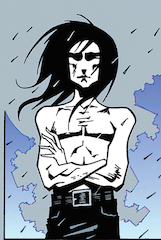 facial images, though there are a few exceptions. I usually love or hate a comic book artist; I rarely, as I do with Hempel, both love and hate different panels on the same page and even different images within the exact same panel. I’ll try to give a few images that I love since I have limited space in this review. But consider yourself warned that many react negatively to Hempel’s art.
facial images, though there are a few exceptions. I usually love or hate a comic book artist; I rarely, as I do with Hempel, both love and hate different panels on the same page and even different images within the exact same panel. I’ll try to give a few images that I love since I have limited space in this review. But consider yourself warned that many react negatively to Hempel’s art.
What should you look for when reading The Kindly Ones? First, look for the Nightmare who is reborn, and then consider what happens to Daniel at end of the story. Might the Nightmare’s transformation prefigure Daniel’s? We might also consider the transformation of Lucifer. Last we saw him, he was on a beach. But he mentioned other interests he might pursue. In The Kindly Ones, we find out where he’s set up shop.
There are also repercussions to look for: Remember Dream’s sorrow over a lost lover when it kept raining in darkness in the Dreaming? There’s a hint that we see her in The Kindly Ones (an extra hint: she draws a circle around Lyta). What repercussions follow that failed relationship? Remember when Loki put himself in the Dream-Lord’s debt when 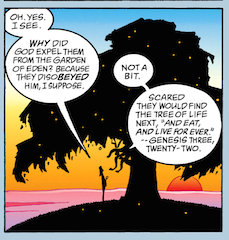 Morpheus did not return him to Odin? What might Loki do when he finds himself owing a favor, and in effect, finding himself beholden to another? Also, what are the repercussions when one becomes angry enough to let loose one’s fury and seek for the greatest revenge in one’s power?
Morpheus did not return him to Odin? What might Loki do when he finds himself owing a favor, and in effect, finding himself beholden to another? Also, what are the repercussions when one becomes angry enough to let loose one’s fury and seek for the greatest revenge in one’s power?
There are many other questions asked and explored: How much suffering can a human withstand? At what point do we cease being rational beings, if we ever are rational to begin with? Why does much of this suffering come as a side-effect of love? And it’s important not merely to note the visual and verbal repetitions throughout the series, many of which are seen in The Kindly Ones, but to ask in each case why Gaiman bothered to employ that particular repetition in that exact way.
 And I should have added “Responsibilities” to the topics of Revenge and Repercussions: Sandman, as we’ve seen before, is bound by many rules and responsibilities, and these define him and guide him; however, considering that he’s known for being preoccupied with his duties, adversaries can manipulate and take advantage of him, knowing that while others may break rules, may shirk duties, under extreme circumstances, Morpheus will predictably follow the rules because he feels honor-bound. So the same rules that define and guide him, in turn, can limit him. It’s interesting to take note of those characters, like Cain, who demand that others follow rules; then we should consider the characters, like Sandman, who seek identity through understanding one’s duties.
And I should have added “Responsibilities” to the topics of Revenge and Repercussions: Sandman, as we’ve seen before, is bound by many rules and responsibilities, and these define him and guide him; however, considering that he’s known for being preoccupied with his duties, adversaries can manipulate and take advantage of him, knowing that while others may break rules, may shirk duties, under extreme circumstances, Morpheus will predictably follow the rules because he feels honor-bound. So the same rules that define and guide him, in turn, can limit him. It’s interesting to take note of those characters, like Cain, who demand that others follow rules; then we should consider the characters, like Sandman, who seek identity through understanding one’s duties.
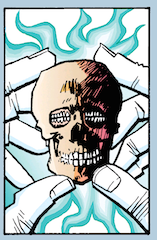 Though I’m temped to take off half a star for some of the blocky art, there’s just too much about the art that I still love. For example, when Lyta wanders the streets, Hempel perfectly conveys her double journey, using alternating panels to flip back and forth between Lyta’s journey through the city streets in the real world and her quest through the dreamlike mystical world she sees that, to us, is layered on top of the harsh urban reality. And though the story is harder to read than many of the other THE SANDMAN story arcs, that’s because it is ambitious in scope, both in terms of the intricate plotting and the multiple themes in the main plot that are echoed in the many sub-plots. I’m amazed Gaiman pulled off this culmination of so many intricate plot strands, most of which started many years ago in previous story arcs. Ultimately, this story is woven more expertly and beautifully than one brought to life by The Kindly Ones.
Though I’m temped to take off half a star for some of the blocky art, there’s just too much about the art that I still love. For example, when Lyta wanders the streets, Hempel perfectly conveys her double journey, using alternating panels to flip back and forth between Lyta’s journey through the city streets in the real world and her quest through the dreamlike mystical world she sees that, to us, is layered on top of the harsh urban reality. And though the story is harder to read than many of the other THE SANDMAN story arcs, that’s because it is ambitious in scope, both in terms of the intricate plotting and the multiple themes in the main plot that are echoed in the many sub-plots. I’m amazed Gaiman pulled off this culmination of so many intricate plot strands, most of which started many years ago in previous story arcs. Ultimately, this story is woven more expertly and beautifully than one brought to life by The Kindly Ones.
~Brad Hawley
![]()
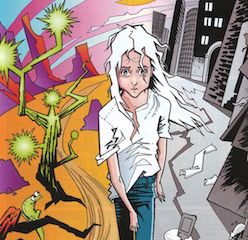 If you are reading this review, I’ll assume you’ve read and liked the previous eight volumes. If you haven’t read them, I suggest you start with Volume 1 and go from there. Otherwise, this review will be full of spoilers and I don’t want the Furies or Corinthian to visit me in my dreams in retribution.
If you are reading this review, I’ll assume you’ve read and liked the previous eight volumes. If you haven’t read them, I suggest you start with Volume 1 and go from there. Otherwise, this review will be full of spoilers and I don’t want the Furies or Corinthian to visit me in my dreams in retribution.
The entire series shifts between collections of short stories and single longer narratives, and some of my favorite THE SANDMAN stories have been the stand-alone stories such as “A Midsummer Night’s Dream,” “Three Septembers and a January,” “The Song of Orpheus,” “Ramadan,” “Hob’s Leviathan,” and “The Golden Boy.” Sometimes I think Gaiman does his best work here, as some of the full-length Sandman story arcs were not as satisfying, particularly “A Game of You.” At the risk of being pilloried by Sandman fans, I felt that “The Kindly Ones” was too long and tried to tie together too many disparate story threads and characters to be a cohesive and effective story. I also have to say that having really admired most of the artwork in the series, the drawings of Marc Hempel that dominate this volume were amateurish and distracting, to the point where I couldn’t recognize the characters even if they appeared in previous  volumes. It made it hard to follow and was far below the high standards of the many other Sandman artists. I’ve read other views and there are a lot of Sandman fans who feel similarly. It’s unfortunate since this is probably the most important volume in the series, and it’s the reason I gave it a 4-star rating.
volumes. It made it hard to follow and was far below the high standards of the many other Sandman artists. I’ve read other views and there are a lot of Sandman fans who feel similarly. It’s unfortunate since this is probably the most important volume in the series, and it’s the reason I gave it a 4-star rating.
The other key point about The Kindly Ones is that any astute reader will know what inevitable end the story is leading towards. This had been foreshadowed throughout the series in more subtle terms, but explicitly at the end of Vol 8 during the reality storm outside the Inn at Worlds’ End. That was a very poignant and powerful moment in the series. The sense of impending and unavoidable doom and tragedy infuse almost every moment of this volume, not least of which being the fatalistic and passive attitude of Morpheus himself. Despite his seeming immortality and dream powers, he seems fairly helpless and resigned to his fate as a host of different characters with grudges against him for past offenses line up to take shots at him. And when one of the them enlists the vengeance of the Furies, the Kindly Ones of the title who are anything but, events have been set in motion that can end only with one outcome.
 The buildup to this is fairly slow, as Gaiman visits almost every human, faerie, and immortal character who has been affected by Morpheus and might have an axe to grind. Morpheus, with his dogged insistence on carrying out the responsibilities of his office, sanctimonious attitude toward his fellow Endless siblings, callous treatment of lovers, and repeated snubs of other immortal beings, has made a surprising number of enemies, and it seems they all choose the same timing to deliver payback to him. The only ones on his side are his loyal servants, especially Lucien the librarian, Matthew the raven, Merv the pumpkin handyman, the guardians of his castle, and most unexpectedly a resurrected figure from Vol 2: The Doll’s House. Arrayed against them are certain pranksters, Norse gods, witches, fallen angels, and plenty of jilted lovers. It hardly seems a fair fight, especially when Dream is not inclined to fight back. He seems almost to court this informal judgment against him, as if he deserves their censure.
The buildup to this is fairly slow, as Gaiman visits almost every human, faerie, and immortal character who has been affected by Morpheus and might have an axe to grind. Morpheus, with his dogged insistence on carrying out the responsibilities of his office, sanctimonious attitude toward his fellow Endless siblings, callous treatment of lovers, and repeated snubs of other immortal beings, has made a surprising number of enemies, and it seems they all choose the same timing to deliver payback to him. The only ones on his side are his loyal servants, especially Lucien the librarian, Matthew the raven, Merv the pumpkin handyman, the guardians of his castle, and most unexpectedly a resurrected figure from Vol 2: The Doll’s House. Arrayed against them are certain pranksters, Norse gods, witches, fallen angels, and plenty of jilted lovers. It hardly seems a fair fight, especially when Dream is not inclined to fight back. He seems almost to court this informal judgment against him, as if he deserves their censure.
So the dramatic tension is sometimes lacking. As the Furies close in on Dream’s realm and his servants, he seems to hardly be making an effort to thwart them. In response to queries by the faerie Nuala of why he does nothing, he replies:
There are old rules, Nuala. Rules that were old when time was young. The [Furies] have power to avenge blood-crimes… And I killed my son. The [Furies] are empowered to hound those who spill family blood. I have Orpheus’ blood on my hands, Nuala.
In a sense, he may feel that he deserves punishment at their hands.
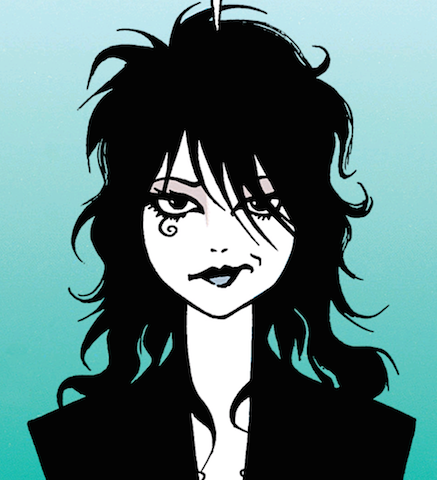
Again, when questioned by Lucien as why he did not protect his other faithful servants, he replies,
Rules and responsibilities: these are the ties that bind us. We do what we do, because of who we are. If we did otherwise, we would not be ourselves. I will do what I have to do. And I will do what I must.
The whole story is modeled on the ancient Greek tragedies, but this attitude most reminded me of King Arthur in The Once and Future King as he goes to confront Mordred and certain death.
The climactic confrontation between Morpheus and the Furies is not a battle in the usual sense of epic fantasy, with blasts of magic, armies clashing, and the final clash between the hero and arch-villain. In fact, it is more a battle of attitudes and moral stances, with both sides bound by their natures and those ancient rules we keep hearing about. So who made the rules? The Creator, yes, but why? And will he intercede in such conflicts? What does this say about the free will of the Endless? Destruction chose to exercise that free will and walk away from everything, but Dream is woven from different cloth. Again, much to contemplate, and still a final volume awaits…
~Stuart Starosta





Thanks for the detailed review, Brad! Especially the insight on what it was like for readers getting the story in monthly installments. I can easily imagine how difficult it would be for readers to recall the details of all these returning characters who they might not have read about for several years. It’s also interesting that Gaiman was writing this with the full volume in mind.
Unlike may others, I’ve had the advantage of reading the entire 10 volumes in a row over a 6-month period. That is a very different experience that monthly installments over 6 years. It definitely helps with continuity, but even I was having trouble recalling the exact details of each character’s back-story in The Kindly Ones. But I do appreciate the intricacies of the plot now, and looking at the entire series as a whole, it’s truly an amazing accomplishment.
Looking forward to your review of the final volume, The Wake, which features my absolute favorite artwork of the series!